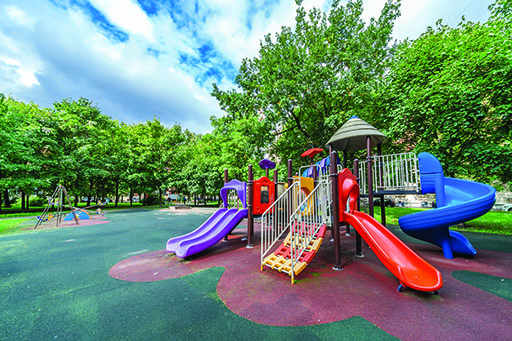4 Playground design principles
The organisation Learning Through Landscapes (LTL) [Tip: hold Ctrl and click a link to open it in a new tab. (Hide tip)] suggests that school staff should ask themselves: ‘Is the school playground a place to enjoy, or a place to endure?’
LTL developed a set of design principles for school playgrounds which you’ll look at now.
According to Learning Through Landscapes (2013), the most important playground design concept is ‘possibility’, so that children can choose and self-direct their play in a wide variety of ways. Another important concept for playground design is the use of ‘non-prescriptive’ features, so that children can use their imaginations in ways that are not directed by adults.
Natural materials and landforms provide both ‘possibility’ and ‘non-prescriptive’ elements. LTL says it can be helpful to think about fixed elements, often related to landform, and loose materials that can be moved and manipulated.
Examples of fixed elements are: mounds, tunnels, slopes, trees, shrubs and woodland, climbing frames, mazes, dens and shelters. These can break up large open spaces into more interesting child-friendly spaces that can be used for imaginative play.
Examples of loose materials are pebbles, seeds, grass, twigs, leaves, pruned branches and flowers, shells, cones, hazel rods or wooden discs. In addition to natural materials, playgrounds can have ‘man-made’ resources such as tarpaulins, pipes, rope, plastic crates, hoops, small toy figures and vehicles, chalk, planks and joinery offcuts. These materials can stimulate a wide range of play activities including den building, construction and the creation of fantasy or ‘small world’ play scenarios. They can stimulate children’s creativity and encourage team work and collaboration.
According to Learning Through Landscapes:
Variety is a key principle in designing a school playground. Any outdoor space will have learning opportunities, but a more varied space will present a wider range of options.
Aesthetics are important; we learn well when we’re in an attractive environment that’s well cared for.
Comfort is a consideration; to be able to sit outdoors, to have a surface to lean on and to find shelter from the wind or shade from the sun.
It’s useful for a playground to have a gathering space where teaching staff can give instructions.
The design of the school building is important. How easy is it for pupils to access the outdoors from their classroom? How easy is it to change into or store outdoor clothing? How feasible is free flow access between indoor and outdoor areas?
LTL says that adults in the playground should be:
…observing closely to gain an understanding of what is happening – not just what children are physically doing but what is going on in their minds and relationships as they do it – and what the impact of this is on children.
Activity 6 Evaluating a playground space
Think back to the video of the tarmac and field playground spaces you observed in Activity 2. List what you see that you think demonstrates any of the following:
- possibilities for play
- non-prescriptive features
- variety
- aesthetics
- comfort
- fixed elements
- loose materials
- boys’ play
- girls’ play
- adult supervision or intervention.
Discussion
The two playgrounds – field and tarmac – are very different in what they offer for children’s play, and aesthetically they are very different in look and feel.
The field area seems to present more possibilities and non-prescriptive features, such as the wild area and the open grass areas. The tarmac playground has markings which are fixed and suggest what children could do, for example, ‘hop on one foot’. These markings seem to offer scope for involvement, and might help children who are unsure what to play on their own or with friends. Children could also take these actions elsewhere, for instance to the field area, and improvise on them. The tarmac markings also encourage children to read and use language in their play.
Both spaces have fixed elements: the tarmac area has ground markings and a climbing wall, and the field has climbing apparatus and benches for children to sit comfortably. Neither area, on the day of filming, had ‘loose materials’ as described by Learning Through Landscapes, although some children have skipping ropes, and there is a table top game and football with pitches.
Both areas encourage locomotor play for girls and for boys. They run freely, walk, skip, and many of them talk as they play. The climbing frame and wobbly bridge seem to encourage gathering and chat. Adults are very present, but standing back and observing.

